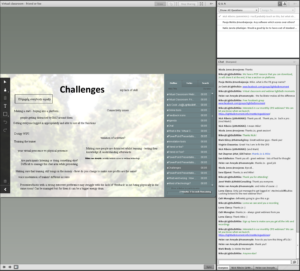In volatile and uncertain economic climates, it’s essential for businesses to leverage the latest technologies to adapt to client demands. For TMSDI, an international provider of psychometric profiling tools, a key component in staying VUCA-proof has been the introduction of webinars and virtual classrooms to cater for train-the-trainer accreditation sessions. Although our traditional “on the ground” workshops have remained popular, in recent years we have found a strong demand for learning in a virtual classroom. Whether it’s for dispersed teams, clients who have limited travel budgets, or the time-poor learner, webinars have helped our business stay agile.
That’s not to say that we haven’t made any mistakes. Here are some that we’ve encountered, and some ideas for how to avoid them:
1) Preparing the same type of slides as you’d use in a face-to-face session
I’ll be honest- I’m not a huge fan of PowerPoint. In a face-to-face sessions I frequently work with flipcharts, physical props, and movement to help convey important concepts. Any slide decks that I do use are often very limited, and ideally there as a last resort to complement what is being discussed/shared.
Webinars demand a different approach. Assuming you are not using video/webcams, your participants will have just your voice to go on, so any visuals you have should be there to complement your audio content, capture attention, and inspire learning. In a virtual environment, the number of distractions is multiplied exponentially – it’s your job to use visuals as part of your toolkit to help maintain attention.
After much experimentation, we discovered a sweet spot: that 1 new slide should appear every 1-2 minutes. More-frequently and your audience will start to experiencing a strobing effect, less-frequently and attention begins to wander. And forget about the snazzy animations – in most virtual learning environments they will judder to a halt by the time your participants eventually see them due to limited bandwidth. Keep any slide builds simple, and go heavy on images, light on text. Haikudeck is a great place to start for webinar-friendly inspiration.
2) Forgetting to manage the energy in the room
Many trainers/facilitators share a preference for Extroversion.**
Depending on the psychometric tool and/or school of psychology that you subscribe to, this means that these types of facilitators have a high need for people contact, talking through their thoughts/ideas, and receiving energy/praise from others. Moreover, the energy that an Extrovert gives out should ideally be returned back to them in a continuous loop.
This can be a challenge when delivering in a virtual environment. For those who have a need for people contact, the lack of non-verbal, in-the-moment feedback is something that can feel a little like flying a plane in fog. Taking time to charge-up your personal energy before and after delivery will help, as will acknowledging that a more-extroverted presenter may feel more drained than usual compared to a piece of face-to-face delivery.
The same goes for participants. They also need to know you’re with them even if they can’t see you. How will you include their thoughts, questions, and contributions in the classroom to ensure no-one feels left out? Which brings us neatly to the other tools of the virtual learning trade…
**Disclaimer: This is, naturally, a sweeping generalisation, based purely on my own experiences of working with a wide variety of trainers/facilitators. Importantly, this is not to say that Extroverted facilitators are necessarily better than those with an Introvert preference (I would go as far as saying some of the best facilitators I’ve worked with are more-Introvert). But…this is all still worth bearing in mind when managing your energy as a presenter.
3) Ignoring the features of a virtual classroom because you wouldn’t/couldn’t use them face-to-face
Most webinar platforms include tools that you often wouldn’t get an opportunity to use when face to face. They can add a lot to a session to assist in gauging your learners’ engagement, adjusting your pace, and creating virtual communities:
Polls are a great way to punctuate virtual learning- as part of a ‘what brings you here today’ intro, a mini-quiz to test knowledge, or a round-up activity to check-in on pace. Most webinar platforms enable live polls to be set-up either on-the-fly or before the webinar begins. The results can be displayed in real time and also as part of tailored follow-up to support learners long after the session finishes.
Collaborative whiteboards can be a great way of capturing questions/comments/ideas, ready for playback in the session, or afterwards. Some platforms (e.g. Webex) allow for breakout sessions and multiple whiteboards, meaning that you can split groups off to work together, then bring them back in plenary to share the output of their discussions. Plus, they can all be recorded automatically to save anyone having to type them up.
In an “on the ground” learning session, it can be disruptive to have people chatting throughout. In a virtual environment, live chat is an effective tool to help learners build connections, check their understanding, and capture questions in real time for the facilitator to tackle at an opportune moment.
4) Assuming technical difficulties won’t happen
There’s a delicate balancing act to tread here. It can be a big drain on resources to go ‘looking for Murphy’ and analyse every possible technical issue that could occur. On the other hand, neglecting to anticipate the most likely issues can mean, at best, your webinar starts much later than planned, or at worst – you have to cancel and reschedule.
Some of the most common issues we have found are:
Internet connection issues
We resolved this in two ways:
1) From our side – to avoid any interruptions or issues with bandwidth, we installed a dedicated broadband line just for webinars. This may seem a step too far, but it’s important to have a Plan B in the eventuality that your internet connection goes down.
2) From the participants’ side – making sure that they are aware that a minimum connection speed will be necessary, and that joining using a mobile data connection or free coffee shop wi-fi is unlikely to cut it.
Audio issues
Most virtual learning solutions have a built-in audio check, to test that the computer/device speakers are compatible with the learning platform you’re using. Label them and make sure your learners know that they’re there when they arrive.
If you’re running a virtual learning session, encourage people to join far ahead of time so that any issues with audio can be ironed out in time for starting. For high value training sessions, we also offer a one-to-one test a week or so beforehand to help make sure the experience is as it should be. Five minutes spent here could save a whole heap of worry on ‘show day’.
If you can, make sure you have a colleague on standby to direct your participants to for tech support so that your presenter can focus on their presenting.
Finally – if in doubt, use a headset. No-one likes the never-ending echo effect in a webinar where others are talking.
The ‘what does that button do’ problem.
A savvy webinar presenter needs to be a master of their panel of controls in order to deliver swan-like, whilst all manner of notifications, alerts and messages are appearing around them.
There’s an easy solution here. Practice, practice and practice again.
Practice ‘driving’ a webinar, pushing all the buttons – just to see what they do – in a safe environment, so that you can be super-confident of your tools and how to use them when the time comes. Of equal importance: practice being a passenger so that you can a sense of what your participants are hearing/seeing/experiencing as you guide them through their learning journey.
 Please get in touch or leave a comment below to share some of your experiences delivering learning solutions in the virtual classroom.
Please get in touch or leave a comment below to share some of your experiences delivering learning solutions in the virtual classroom.
About our guest blogger
Mark Gilroy is Managing Director of TMS Development International Ltd, a leading global provider of psychometric development tools designed to create, nurture and sustain high performing teams. Mark has a background in psychology and has been working in the L&D arena as an executive coach and team development facilitator for over a decade.







